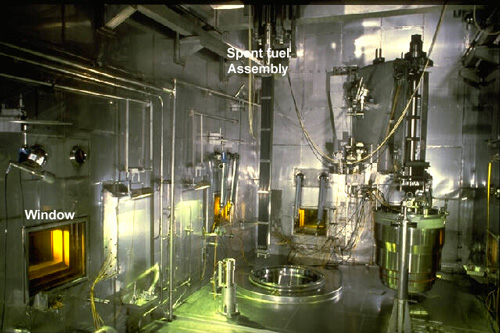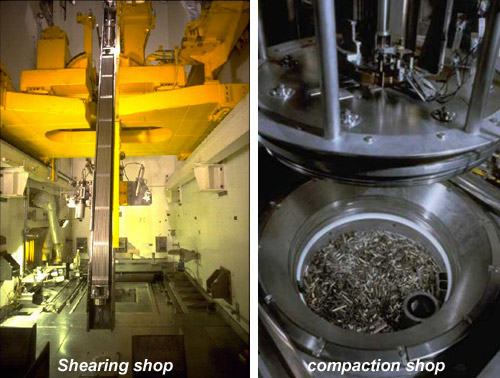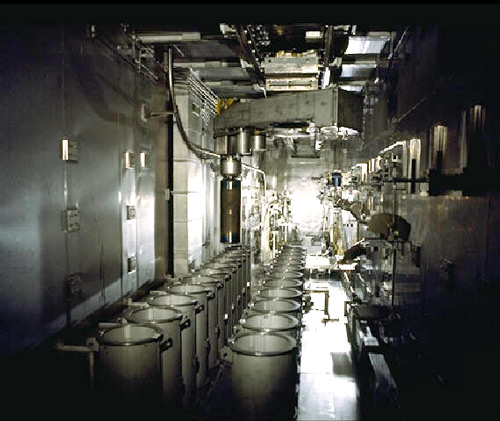A multi-year sequence of operations

Spent fuel unloading
This is the first stage of the spent fuel’s journey at La Hague plant. Overview of the dry unloading shop, where robots remove spent fuel assemblies from their transport cask, which is tipped into a vertical position. The fuel assemblies are then lowered through a shaft into a large pool, where they will be allowed to cool for several years before going to the actual processing stage.
© Sydney Jezequel/AREVA
Reception of the spent fuel assemblies is the first stage of operations at the La Hague reprocessing plant. The fuel assemblies are brought from the nuclear power plant’s spent fuel pit, where they will already have been stored for around a year.
Upon arrival in La Hague, the fuel assemblies are unloaded from their « transport casks » for an additional period in storage. Despite the time spent in storage in the reactor’s spent fuel pit, the material is still extremely radioactive at this stage. Its activity is in the region of 2 million curies or 75,000 TBq per tonne. Unloading is carried out underwater using a robotised process, as are all subsequent operations.
Once unloaded, the fuel assemblies are stored in racks on the floor of a large pool at least 9 m deep. The racks are made of borated steel to prevent any criticality risk. As fuel assemblies are around 4.5 m long, the pool depth must be twice this figure, to allow underwater loading and provide radiation protection for operators.
There are five pools of this type at the La Hague facility. Fuel assemblies are stored in them for between five and eight years. This allows time for their activity to decay sufficiently to enable the shearing and separation steps to be carried out.

Shearing and compacting fuel assemblies at La Hague
(Left) A feed unit supplies the spent fuel shearing and dissolving shop. Fuel rods arriving at the shearing shop are chopped into pieces to release the irradiated uranium pellets, which are then dissolved in a bath of nitric acid. (Right) After the shearing operation, the Zircaloy alloy hulls and end caps are collected in the La Hague plant’s compaction shop, where they are compacted and transformed into ILW-LL waste packages.
© Sydney Jezequel/ Les films de Roger Leenhardt/AREVA
Pellets of uranium oxide fuel pellets are stacked inside zircaloy tubes known as rods. Between 200 and 300 rods, held together by end caps, form a fuel assembly. To remove the irradiated pellets from their cladding, the end caps are separated and then a large guillotine chops the rod bundles into sections a few centimetres long. The fragments of cladding hull fall, together with their contents, into a bath of boiling nitric acid. The hulls and end caps, which are insoluble in acid, are separated and rinsed. They will be transformed into ILW-LL waste. .
Irradiated uranium oxide pellets contain an extremely diverse mix of solid, liquid and gaseous chemical elements. When they have been dissolved in the nitric acid bath, the uranium and plutonium are extracted and separated, leaving a residue consisting of ffission products and minor actinides. This hot chemistry, rendered difficult by the extremely radioactive conditions, is automated.
The residues, which contain almost 99% of the initial activity are calcined and then mixed with glass frit. The resulting glass is poured into stainless steel containers with a capacity of approximately 200 l.

Vitrified waste containers
Overview of the cooling chamber in vitrification shop at the spent fuel processing facility (UP2 800) in La Hague. The vitrified waste containers obtained after separating out the uranium and plutonium pass through this chamber before being stored in ventilated shafts such as the one being prepared here.
© Sydney Jezequel/AREVA
These containers will become high-level (HL) waste. They are stored in ventilated shafts. Waste owned by overseas companies is sent back to its owner. French waste remains in provisional storage at La Hague, pending definition of a management strategy.
The process also generates intermediate-level waste: settling and centrifuging products, sludge and filters, as well as the fuel assembly hulls and end caps separated and rinsed during the shearing operation. These items and other technological waste are compacted in metal drums, whereas other products such as sludge are evaporated and concentrated before being added to the vitrified waste.
Other articles on the subject « Fuel reprocessing »
Purex process
Purex – Industrialised spent fuel processing Fuel is processed at the LaHague facility using a hy[...]
Reprocessing performance
Past achievements and future improvements When the plant in La Hague was commissioned in 1976, it[...]
Effluents and releases
Low and well-controlled environmental releases A small portion of the radioactive waste from nucl[...]
La Hague – Safety
Safety issues different to those faced by reactors The events of 11 September 2001 raised the spe[...]